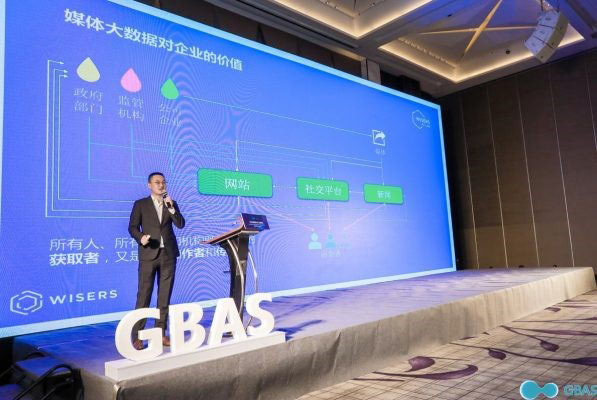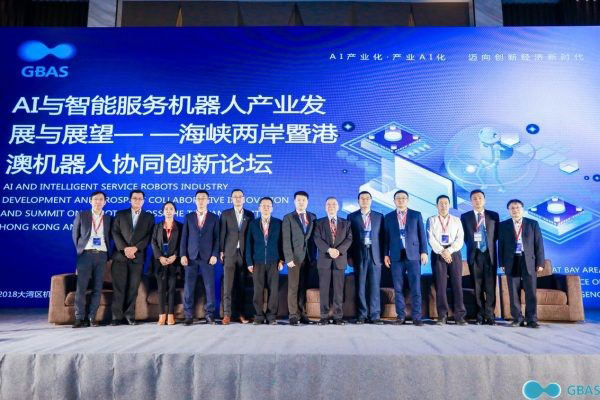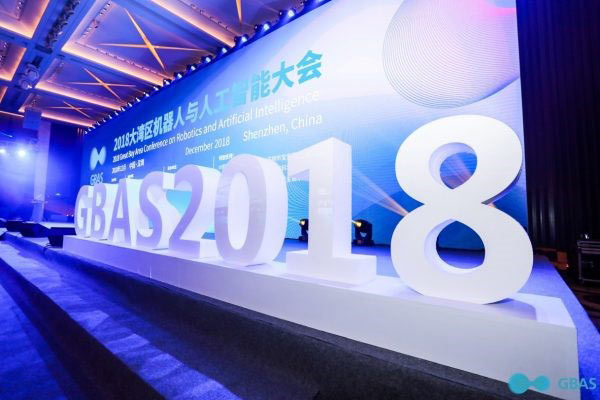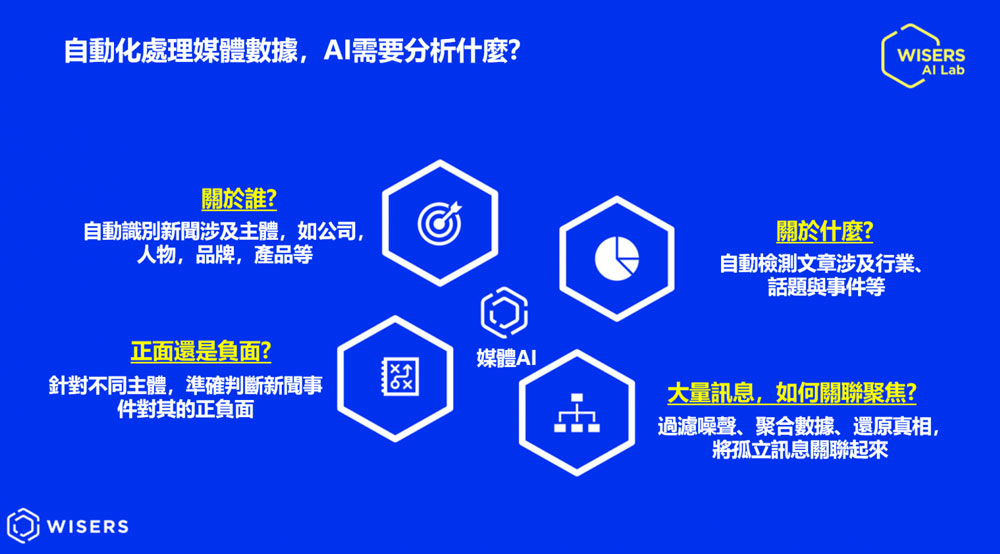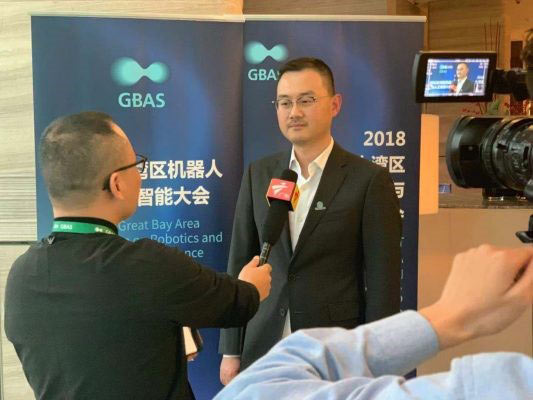2018 Great Bay Area Conference on Robotics and Artificial Intelligence was held in Shenzhen on 6 and 7 December 2018. The Conference was jointly organised by China Centre for International Science and Technology Exchange, Shenzhen Association for Science and Technology and Shenzhen Industry-University-Research Institute Collaboration Association (SZIUR). Talents from a variety of disciplines joined the Conference and exchanged views on the evolution and applications of robots and AI. Wisers, as a key contributor to technological collaborations in the GBA, was invited to the Conference.
Dr. He Chao, Vice President of Wisers and Founder of Wisers AI, delivered a speech on 7 December titled “Identifying Cross-Regional Financial Risks via Omni-media AI”. Dr. He shared how omni-media big data and AI technologies, in particular, text recognition and semantic processing, can help identify cross-regional financial risks, assisting enterprises, investors and regulators in managing risks and making smart decisions, especially in view of today’s sophisticated macroeconomic environment and increasingly close cross-regional cooperation.
In his speech, Dr. He pointed out that all media big data contain rich and valuable information. Thanks to AI technology such as Natural Language Processing, all information can be completely and instantly mined, including macroeconomic policies, international trading environment, global political climate, financial regulations, industry dynamics, margin trading, business operations, and even customers’ preferences and comments on a specific product. Such information together with “sentiment analysis” and corporates’ own data can help investment institutions and enterprises to take preemptive moves on the market. Enterprises can have a full picture of the macro environment and have a firm grasp of the investment market and competitors, explore business opportunities and manage risks. With spot-on marketing strategies, enterprises can maximize their investment returns.
Citing a case where cross-regional financial risk was identified, Dr. He vividly showed how Wisers’ AI algorithm model excels in extracting valuable information from omni-media big data. A company with its major exporting market in the United States received far fewer orders due to the Sino-US trade war, and with the escalating trade conflict, the entire industry chain of the electronics industry was plagued with negative news on the Internet, such as massive layoffs and late payments to suppliers. Wisers used omni-media data with technology tools such as AI analysis and knowledge maps to monitor immediately the negative news of the said company and across the electronics industry. A pre-emptive alert was sent to the said company’s mother company, its banker, investment institutions and regulatory authorities to ensure financial risks were under control and the best decisions can be made to cope with contingencies. Having received the alert, the company’s banker can immediately and comprehensively assess and analyse risks related to the said company’s repayment ability and the guarantee from its parent company; investment institutions can promptly change investment strategy and adjust position to mitigate losses; regulatory authorities can quickly hash out policies to motivate industrial development, support affected enterprises and increase domestic demand, as well as relax the requirements on short-term loans to help industries and enterprises weather through difficulties. Collaborating with one another, enterprises or industries may see good news, which can also be detected by Wisers’ AI technology. Financial institutions can thus adjust credit line, increase investment and leverage business opportunities.
According to Dr. He, analysing media text data with AI is no simple task. He cited two interesting examples: a banner on top of a school restaurant with “Welcome new and old teachers and students to have meals here” (this message can also be read as “Welcome new teachers, while still alive, to have meals here”), showing how the lack of basic syntax analysis and punctuation can result in big interpretation problems. Another example is a news headline related to “Ginseng” where the herbal remedy may be mistaken as “Citibank” because their first two characters in Chinese are the same. The simple keyword matching and basic analysis may lead to different semantic interpretations.
For AI technology’s semantic analysis is applied to first identify the “who” in the text, which is to identity entities, such as the name of a company, person, brand and product, as well as location, time, title, media source and author. After identifying the entity names, the system needs to figure out the connection between these entities to solve the problem of keyword clustering and eliminate semantic ambiguity. For example, some companies may have the same name in real life, and a knowledge map is needed to find out their connection. The relationship among various companies in the financial, investment and financing industry is highly complicated. Wisers has brought together AI text analysis technology and knowledge map to analyze raw data and introduce a structure to them. Isolated data are linked together to form a full picture of mapped data about a company or entity, so that financial practitioners can conduct with ease a wide range of background checks and risk assessments.
The second step is to figure out the “what” of the text. AI Technology is used to convert the text into topic tags loaded with semantic information, then the data will be applied to project on the analysis results. Traditional mechanical learning technology required labeling to be done on a considerable amount of training data. Each topic needed to be labeled with ten of thousands of training data. Understandably, such tasks were time-consuming and lacked scalability. On unforeseen data, the trained model may fail to give a credible analysis result as well. The AI semantic vector model has amassed a lexicon of over nine million terms, developed by Wisers through 20 years of media data monitoring. The topic classification technology constructed by this model is capable of accurately analysing the semantic information of each phrase and its correlation with the full text. In this way, the text content can be automatically labeled with high speed and precision, satisfying the demand of different clients on different topics, thus saving time on information classification.
Lastly, in corporate decision-making, enterprises should be informed of both positive and negative news, which involves AI “sentiment analysis” technology. AI technology from Wisers excels in automatic recognition of sentiments conveyed in the text. On top of full-text analysis, there are also benchmarks set for various industrial applications, aiming at multi-tier correlation sentiment analysis with unique precision of a particular subject, entity or dimension. Wisers’ sentiment analysis model has been well recognised by numerous media authorities for its trustworthiness and reliability. Thanks to Wisers’ sentiment analysis model, National Business Daily, 21st Century Business Herald and CBN weekly completed their buzz analysis. What’s more, it helped a dozen of top financial institutions to monitor credit and investment risks.
Dr. He talked to the media after the Conference. He pointed out that “AI+ Industry” should be the development direction and focus of Wisers. In view of current development constraints of AI technology, Dr. He called for the integration of humans and AI: AI to handle 80% or 90% of cumbersome works, releasing manpower to focus on knowledge-based decision-making tasks, which AI technology has yet to accomplish. Dr. He also stated that synergies and innovations achieved through collaboration across the Taiwan Strait and the Greater Bay Area are conducive to the development and cooperation in science and technology industries in Guangdong, Hong Kong, Macao and Taiwan. With 20 years of experience, Wisers has built a team of more than 1,000 people working daily across nine offices in Greater China, and having served approximately 3,000 customers, helping customers make smart decisions as well as integrating human resources and technologies in these four places. Wisers is the pioneer in promoting collaborative innovations. It served as one of key service providers introducing AI technology to big data for vertical industries. As a governing member of the Guangdong Intelligent Innovation Association and a keen promoter of the Hong Kong Society of Artificial Intelligence and Robotics, Wisers continues its active engagement in GBA’s scientific and technological innovations and collaborative development. It is hoped that with the initiatives led by the China Industry-University-Research Institute Collaboration Association, more exchange and collaboration opportunities will be shared among excellent science and technology companies in the GBA and worldwide. Wisers aims to develop AI technology proudly made in China and contribute to the collaborative prowess in Greater China.
Established in Hong Kong in 1998, Wisers was founded with pioneering technology from the Chinese University of Hong Kong starting with a news search engine. Wisers has built up a twenty-year track record, with a team of more than 1,000 people working across nine offices in Greater China, and having served approximately 3,000 enterprise and government customers. Wisers is the world’s leader in Chinese omni-media big data with expertise in smart business intelligence. At its core, there are three business units under Wisers, namely Wisers AI, an AI big data business unit empowering vertical industries through “AI+ Big Data”; WisersAnalytics, a research analysis business unit interpreting business value behind big data; WisersOne, a software application business unit as a one-stop platform for PR, marketing and communications solutions through smart big data. Since its establishment in 2014, Wisers AI is dedicated to research and development of innovative AI technologies, focusing on automatic processing and analysis of diversified media data. Enormous amount of media data is analysed to meet the business needs of various vertical industries.
Having years of experience in the field of AI, Wisers has championed natural Chinese semantics analysis with the help of AI, earning worldwide recognition with numerous awards and honours in just a couple of years. At the 7th International Conference on Natural Language Processing and Chinese Computing (NLPCC 2018) in August 2018, Wisers AI ranked first ahead of 17 local and overseas teams under the Single Document Summarisation category. With the theme of “Smart Retail; Digital Transformation”, the Hackfest Day was organised by Decathlon and Microsoft in November 2018, in which Wisers won the “All-round Championship” on the strength of its professional smart data solution.
The success of the 2018 Great Bay Area Conference on Robotics and Artificial Intelligence will help to promote research and development of robotics and AI in the four places across the Strait. In the forum on collaborative innovations, AI experts and professors from Taiwan National Tsing Hua University and the University of Macau shared with forum guests achievements from their latest research and development with regards to big data, AI, blockchain technology with the Internet of Things, smart agriculture and eHealth. With relentless dedications from Wisers and various technology enterprises, audacious in their promotion of AI products and applications, the research and development as well as applications of AI technology will bring a far-reaching and positive impact on various industries in China in the long run. Its progressive growth will contribute to the application and development of AI technology proudly made in China.

